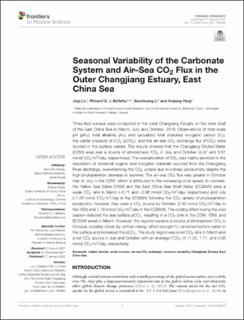| dc.contributor.author | Liu, Jing | |
| dc.contributor.author | Bellerby, Richard | |
| dc.contributor.author | Li, Xiaoshuang | |
| dc.contributor.author | Yang, Anqiang | |
| dc.date.accessioned | 2022-07-12T14:26:22Z | |
| dc.date.available | 2022-07-12T14:26:22Z | |
| dc.date.created | 2022-05-20T14:46:54Z | |
| dc.date.issued | 2022 | |
| dc.identifier.citation | Frontiers in Marine Science. 2022, 8, 765564. | en_US |
| dc.identifier.issn | 2296-7745 | |
| dc.identifier.uri | https://hdl.handle.net/11250/3004706 | |
| dc.description.abstract | Three field surveys were conducted in the outer Changjiang Estuary on the inner shelf of the East China Sea in March, July, and October, 2018. Observations of total-scale pH (pHT), total alkalinity (AT), and calculated total dissolved inorganic carbon (CT), the partial pressure of CO2 (pCO2), and the air–sea CO2 exchange flux (FCO2) were studied in the surface waters. The results showed that the Changjiang Diluted Water (CDW) area was a source of atmospheric CO2 in July and October (4.97 and 8.67 mmol CO2/m2/day, respectively). The oversaturation of CO2 was mainly ascribed to the respiration of terrestrial organic and inorganic materials sourced from the Changjiang River discharge, overwhelming the CO2 uptake due to primary productivity despite the high phytoplankton biomass in summer. The air–sea CO2 flux was greater in October than in July in the CDW, which is attributed to the increasing wind speed. In contrast, the Yellow Sea Water (YSW) and the East China Sea Shelf Water (ECSSW) were a weak CO2 sink in March (–0.71 and –2.86 mmol CO2/m2/day, respectively) and July (–1.28 mmol CO2/m2/day in the ECSSW) following the CO2 uptake of phytoplankton production, however, they were a CO2 source by October (3.30 mmol CO2/m2/day in the YSW and 1.18 mmol CO2/m2/day in the ECSSW). The cooling effect during the cold season reduced the sea surface pCO2, resulting in a CO2 sink in the CDW, YSW, and ECSSW areas in March. However, the regions became a source of atmospheric CO2 in October, possibly driven by vertical mixing, which brought CT-enriched bottom water to the surface and increased the pCO2. The study region was a net CO2 sink in March and a net CO2 source in July and October with an average FCO2 of –1.25, 1.71, and 3.06 mmol CO2/m2/day, respectively. | en_US |
| dc.language.iso | eng | en_US |
| dc.publisher | Frontiers | en_US |
| dc.rights | Navngivelse 4.0 Internasjonal | * |
| dc.rights.uri | http://creativecommons.org/licenses/by/4.0/deed.no | * |
| dc.title | Seasonal Variability of the Carbonate System and Air–Sea CO2 Flux in the Outer Changjiang Estuary, East China Sea | en_US |
| dc.title.alternative | Seasonal Variability of the Carbonate System and Air–Sea CO2 Flux in the Outer Changjiang Estuary, East China Sea | en_US |
| dc.type | Peer reviewed | en_US |
| dc.type | Journal article | en_US |
| dc.description.version | publishedVersion | en_US |
| dc.rights.holder | Copyright © 2022 Liu, Bellerby, Li and Yang. | en_US |
| dc.source.pagenumber | 16 | en_US |
| dc.source.volume | 8 | en_US |
| dc.source.journal | Frontiers in Marine Science | en_US |
| dc.identifier.doi | 10.3389/fmars.2021.765564 | |
| dc.identifier.cristin | 2026023 | |
| dc.relation.project | Norges forskningsråd: 321890 | en_US |
| cristin.ispublished | true | |
| cristin.fulltext | original | |
| cristin.qualitycode | 1 | |

